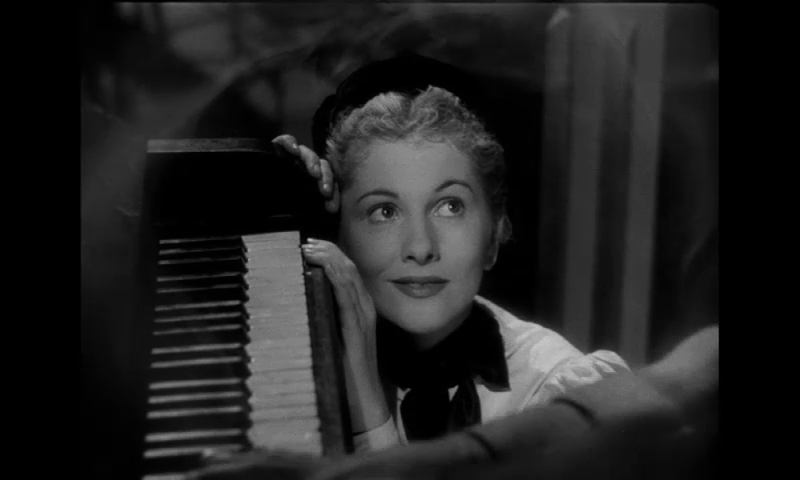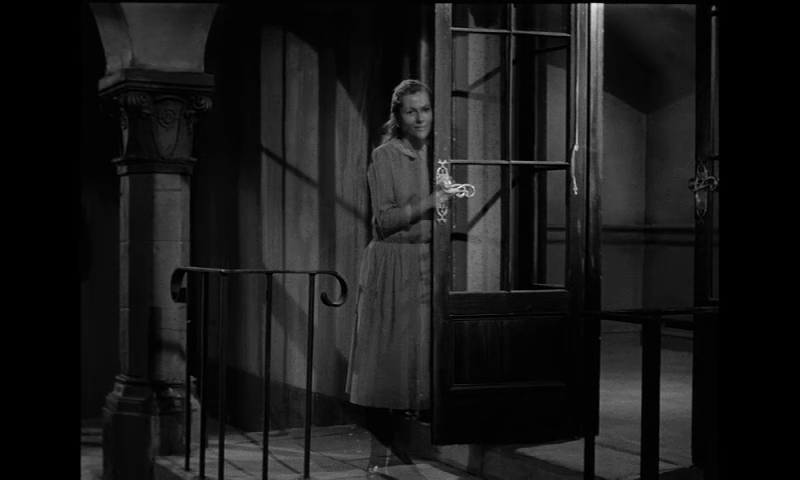Max Ophüls’ 1948 film Letter from an Unknown Woman is a visually stunning adaptation of Stefan Zweig’s 1922 short story “Letter from an Unknown Woman.” The narrative unfolds as a series of flashbacks, told from Lisa Berndle’s (Joan Fontaine) point of view while Stefan Brand (Louis Jordan) reads the letter of the events. The short story ends with Stefan in a state of unease and is unable to remember Lisa after reading the letter. Ophüls utilizes flashbacks, music, voice-over narration, and close-ups to impact the stakes and resolution of the narrative. While Zweig’s story concludes in a way that is incomplete and ambiguous, Ophüls’ film provides a fuller, more dramatic resolution to both Lisa’s and Stefan’s narratives.
Zweig’s short story ends with the novelist R. (Stefan in the film) remembering hardly anything about the woman (her name is not mentioned anywhere in the story). The reader can relate to R.’s confusion because, like him, we are reading this letter with no idea who this woman is, leading us to question her purpose in the story. R. is characterized as an oblivious celebrity who is confronted with the woman’s account of her passion for him. The story ends with his the woman’s death and his struggle to recall her: “An intimation of death came to him, and an intimation of deathless love. Something welled up within him; and the thought of the dead woman stirred in his mind, bodiless and passionate, like the sound of distant music.” But what exactly this “intimation of death” means is ambiguous and imprecise, with no epiphany or character development for the novelist, R., who cannot precisely recall the woman with whom he had an affair and fathered a child.
In Ophüls’ film, the letter is delivered under very different circumstances: its recipient, Stefan, a concert pianist, has been challenged to a duel, one that will likely end his life, and so he plans instead to flee. But then arrives Lisa’s letter, and as he reads, the events of their affair are dramatized. Many of the events of the film are similar to those of Zweig’s novella, save for several changes necessitated by the Hays Code: for instance, Stefan sleeps with Lisa just once (not three times); allusions to prostitution are deleted; and their affair is commented on by nuns after Lisa’s death, a kind of moral judgment on their illegitimate affair.
The heartbreaking end when Stefan remembers Lisa.
The conclusion to Ophüls’ film presents a far more complete and emotional understanding to how Stefan feels in response to reading the letter. Film critic Dennis Grunes calls the presentation of memory in these scenes “a repository of our humanity” (par. 8). Remembering and forgetting allows us to shape our humanity. At first, Stefan remembers nothing of his time with Lisa. But after reading the letter, his memory is cracked by bits and pieces that he seems to recall through the flashbacks. The inability to conjure definite images and words from our lifelong memory bank defines our imperfect, flawed humanity. Guilty for not acknowledging love and forgetting her, Stefan decides to face his fate: he accepts the challenge of the duel which he will surely, both viewers and he understand, will lose.
As Lisa concludes her last words, the image fades to a close up of the last few lines, blotched with ink are seen, along with a zoom in on the attached note. The score is low and grim but suddenly rings with shrill melancholy as Stefan slowly looks up. Stefan has realized just how much devotion this woman had for him and that he will never be able to speak to her again. A montage of memories he had with Lisa ebbs and flows in the form of flashbacks, each frame including a soft iris overlay around the focus of each shot. All of the shots focus on Lisa. The flashbacks are interrupted with a booming, suspenseful tone and an graphic match cut to Stefan, hands in his face. The booming score signals his memory coming back in bits and pieces, not yet complete but visually significant. All he and the audience sees is her face.

Ophüls pays close attention to facial reactions in Lisa’s face.
Stefan’s mute butler John (Art Smith) enters and, in an extreme closeup, writes “Lisa Berndle” on a piece of paper. Stefan whispers Lisa’s name. John is the one character who remembers both her face and name. Stefan now has her name and remembers a face. Stefan and John are disturbed by galloping outside. Stefan goes to the window to make his escape. The camera tracks him and the music score maintains a low, tense rhythm. Cut to the horses’ hooves and a carriage: Stefan’s opponent has arrived. Stefan briefly contemplates his attempt to flee. He moves away from the window and prepares himself to go through with the ordeal.
Stefan goes to the desk with the vase of flowers. He takes a bulb in his hand. Lisa is heard in a brief voice-over. It is the final line of the film and the only moment where she is gone, visually, yet remains with Stefan as “an intimation of deathless love” as he places the white flower in his breast pocket.
In a tracking shot, Stefan goes out the front door, stops, and turns around to see, superimposed, a transparent figure of Lisa leaning against the front door. This harks back to the beginning when Stefan first meets her face to face. The door is open for him to leave as if she is with him til the end. In this way, she is the key that opens the door to face his death.

Lisa’s transparent image appears as Stefan remembers seeing her there long ago.
Ophüls’ Letter from an Unknown Woman has an emotional ending that leaves the audience on a bittersweet note with the use of flashbacks, music, closeups and voice-over, compared to the lackluster and ambiguous end of Zweig’s story. The emotional impact is strongest when the name and visual images of Lisa appear to Stefan at the end, all shown through cinematography and emphasized with the score. These techniques of a filmmaker in control of his medium brought significant, imaginative changes to limitations of the source material, in the end crafting a narrative that concludes with a far more fully satisfying and consequential resolution for both protagonists.

Trackbacks/Pingbacks